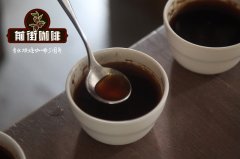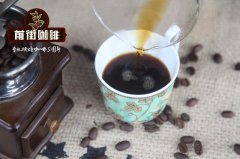Guatemala boutique manor coffee beans peak manor washing Kaduai flavor and taste characteristics?

Professional coffee knowledge exchange more coffee bean information please follow the coffee workshop (Wechat official account cafe_style)
Guatemala boutique manor coffee beans peak manor washing Kaduai flavor and taste characteristics?
Flavor: fruit, sweet-scented osmanthus, raspberry, toffee
One of the most special features of La Cumbre is its location, just south of Guatemala City, just on the edge of this bustling city. Farms in the same area are usually very small, 2 to 4 hectares at most, but the peak is 40 hectares! And the altitude is very high, the highest point is more than 1800 meters!
Federico, a retired agrotechnician who grew up on a coffee farm, loved coffee, studied agricultural economics in college, and naturally became an expert in agro-technology related to coffee. From 1959 to 1964, he worked in International Coffee Organisation. ICO) works in Guatemala. When he retired in 1990, he bought the estate and began to pursue his coffee dream since he was a child. Because the manor was located on the highest peak in the nearby area, he decided to rename it "La Cumbre". For years, the farm has only produced commercial-grade raw beans, and this year's 2016 harvest season is the first year to produce boutique coffee.
Almost 100% of the coffee grown on the estate is Catuai, which is less affected by leaf rust because of its extremely high altitude, but fertilizer must still be applied frequently to maintain Kaddura's high yield and health. As an expert in agricultural technology, he is very restrained in the use of chemical fertilizers and leaves a large area for forests and fruit trees (avocados). Only 20 hectares out of 40 hectares grow coffee.
Due to proper care, the average age of coffee trees is 25-30 years old, but they are still very healthy. And can maintain high production. In addition to Kaduai, Federico also began experimenting with other beans, such as Villa Sashi and Obata. At the beginning of the harvest season, fresh fruit harvested by hand is sent 40 kilometers away every day and is also handled by a family-owned washing plant.
After the cherry fresh fruit arrives at the washing plant, the floating beans will first be removed through the sink, usually immature or damaged beans, the heavier and mature cherries will sink to the bottom of the water, they will go into the peeling machine to remove the peel and pulp, and then will be quickly treated by the pectin machine to remove the remaining pectin mucus, which will be transported to the sink and washed again, this time manually. After this process, all the pectin is washed and soaked in clean water overnight. The next morning, the shelled beans are drained and placed in the sun to dry. The thin layer is laid out and turned frequently with a plank until the moisture content is 11.5%. The drying period usually takes 3-4 days.
Kaduai Catua í
Catua í is a hybrid of yellow Kaddura (Yello Caturra, a variety of bourbon, code C476-11) and "New World" (Mundo Novo, a hybrid of Tibica Typica and Bourbon Bourbon, code CP 374-19). It was developed in 1949 by the Campinas Institute of Agronomy (IAC; Instituto Agronomico do Campinas) in the state of Sao Paulo, Brazil.
After several generations of individual selection, red and yellow Kaduai was officially released in 1972. Since the 1970s, it has been extended to Central American countries, widely planted in Guatemala, Honduras, Costa Rica and other countries, and is also quite common in Brazil, the original development place.
Kaddura has a large yield, which is comparable to that of Kaddura and much higher than that of Bourbon varieties, in part because the plant is small and can be planted densely, reaching twice the density. The shape of the tree is also convenient for farmers to carry out anti-disease and insect operations. Kaduai's short plants, easy to harvest by farmers, are strong trees that can withstand strong winds and rain, but are vulnerable to leaf rust and coffee berry disease.
As for flavor, as long as enough fertilizer is applied, it is recognized as quite outstanding, especially at high elevations above 1300 meters. Guatemala introduced Kaduai in 1970, accounting for 20% of the country's output.
Production area: Fraijanes
Farm: peak Manor Finca La Cumbre
Farmer: Federico Cruz Sandoval
Altitude: 1675-1825 m
Farm area: 40 hectares
Bean seed: Kaduai Catuai
Treatment: full water washing Fully washed; drying in the sun field
Important Notice :
前街咖啡 FrontStreet Coffee has moved to new addredd:
FrontStreet Coffee Address: 315,Donghua East Road,GuangZhou
Tel:020 38364473
- Prev

Characteristics of Salvadoran Coffee at Tomatoes on sticks Manor in El Salvador
For more information on coffee beans, please follow the coffee workshop (Wechat official account cafe_style). The landowner recounts that he came to this land with the Spanish colony in 1543. Apaneca means Rivers of Wind (River in the Wind) in this romantic land, located in the central volcanic belt of ilamatepeque in El Salvador.
- Next

Characteristics of Guatemalan Coffee in Black Angel Manor of Guatemala
Professional coffee knowledge exchange more coffee bean information please follow the coffee workshop (Wechat official account cafe_style) Black Angel Manor EL GISQUILAR Black Angel Manor began in January 1965. This farm is for Democracy Municipality, Huehuetenango, Guatemala. Altitude 1670m2100m. Connecting the Mexican border. For Guatemala
Related
- Detailed explanation of Jadeite planting Land in Panamanian Jadeite Manor introduction to the grading system of Jadeite competitive bidding, Red bid, Green bid and Rose Summer
- Story of Coffee planting in Brenka region of Costa Rica Stonehenge Manor anaerobic heavy honey treatment of flavor mouth
- What's on the barrel of Blue Mountain Coffee beans?
- Can American coffee also pull flowers? How to use hot American style to pull out a good-looking pattern?
- Can you make a cold extract with coffee beans? What is the right proportion for cold-extracted coffee formula?
- Indonesian PWN Gold Mandrine Coffee Origin Features Flavor How to Chong? Mandolin coffee is American.
- A brief introduction to the flavor characteristics of Brazilian yellow bourbon coffee beans
- What is the effect of different water quality on the flavor of cold-extracted coffee? What kind of water is best for brewing coffee?
- Why do you think of Rose Summer whenever you mention Panamanian coffee?
- Introduction to the characteristics of authentic blue mountain coffee bean producing areas? What is the CIB Coffee Authority in Jamaica?

